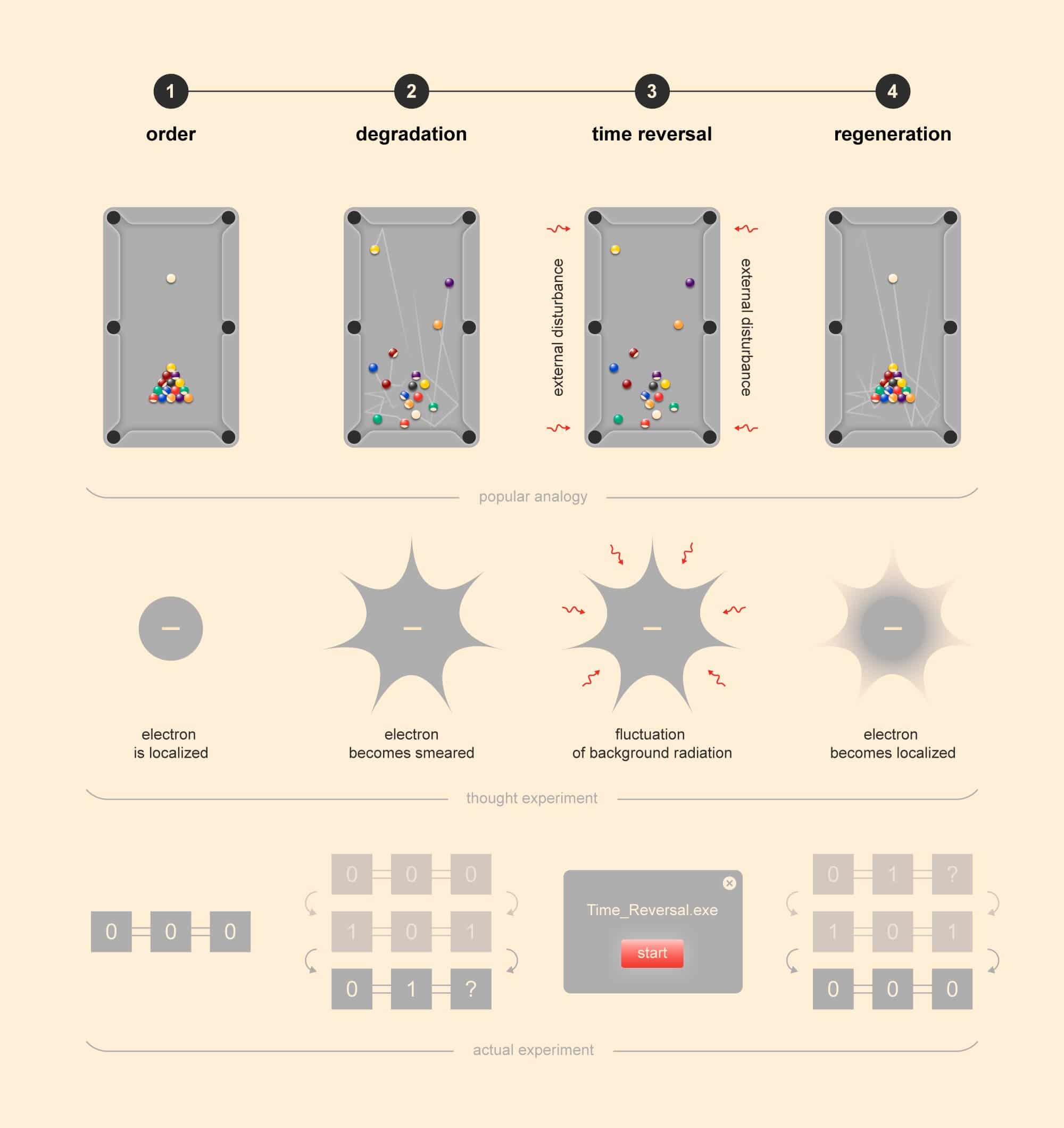Scientists at the Moscow Institute of Physics and Technology in collaboration with scientists from the U.S. and Switzerland have returned the state of a quantum computer a fraction of a second into the past. Moreover, they calculated the likelihood that an electron in empty interstellar space will suddenly go once more into its ongoing past.
Uncovering the origin of the arrow of time remains a fundamental scientific challenge. Within the framework of statistical physics, this problem was inextricably associated with the Second Law of Thermodynamics, which declares that entropy growth proceeds from the system’s entanglement with the environment. It remains to be seen, however, whether the irreversibility of time is a fundamental law of nature or whether, on the contrary, it might be circumvented.
The study’s lead author Gordey Lesovik said, “This is one in a series of papers on the possibility of violating the second law of thermodynamics. That law is closely related to the notion of the arrow of time that posits the one-way direction of time from the past to the future.”
“We began by describing a so-called local perpetual motion machine of the second kind. Then, in December, we published a paper that discusses the violation of the second law via a device called Maxwell’s demon. The most recent paper approaches the same problem from a third angle: We have artificially created a state that evolves in a direction opposite to that of the thermodynamic arrow of time.”
Scientists were keen to know if time could spontaneously reverse itself at least for an individual particle and for a tiny fraction of a second. Thus, they decided to check and examine a solitary electron in empty interstellar space.
Study co-author Andrey Lebedev from MIPT and ETH Zurich said, “Suppose the electron is localized when we begin observing it. This means that we’re pretty sure about its position in space. The laws of quantum mechanics prevent us from knowing it with absolute precision, but we can outline a small region where the electron is localized.”
“The advancement of the electron state is represented by Schrödinger’s equation. In spite of the fact that it sees no difference amongst the future and the past, the region of space containing the electron will spread out all around rapidly.”
“That is, the system will in general turn out to be more chaotic. The vulnerability of the electron’s position is growing. This is practically equivalent to the increasing disorder in a large scale system, for example, a billiard table—because of the second law of thermodynamics.”
Valerii Vinokur, a co-author of the paper, from the Argonne National Laboratory, U.S. said, “However, Schrödinger’s equation is reversible. Mathematically, it means that under a certain transformation called complex conjugation, the equation will describe a ‘smeared’ electron localizing back into a small region of space over the same time period. Although this phenomenon is not observed in nature, it could theoretically happen due to a random fluctuation in the cosmic microwave background permeating the universe.”
Scientists then set out to ascertain the likelihood to observe an electron “smeared out” over a small amount of a second immediately localizing into its recent past. It worked out that across over the entire lifetime of the universe—13.7 billion years—observing 10 billion freshly localized electrons consistently, the reverse evolution of the particle’s state would just happen once. Also, and, after it’s all said and done, the electron would travel close to a mere one ten-billionth of a second into the past.
Large-scale phenomena involving billiard balls and volcanoes obviously unfold on much greater timescales and feature an astounding number of electrons and other particles. This explains why we do not observe old people growing younger or an inkblot separating from the paper.
The researchers then attempted to reverse time in a four-stage experiment. Instead of an electron, they observed the state of a quantum computer made of two and later three basic elements called superconducting qubits.

Stage 1: Order. Each qubit is initialized in the ground state, denoted as zero. This highly ordered configuration corresponds to an electron localized in a small region, or a rack of billiard balls before the break.
Stage 2: Degradation. The order is lost. Just like the electron is smeared out over an increasingly large region of space, or the rack is broken on the pool table, the state of the qubits becomes an ever more complex changing pattern of zeros and ones. This is achieved by briefly launching the evolution program on the quantum computer. Actually, a similar degradation would occur by itself due to interactions with the environment. However, the controlled program of autonomous evolution will enable the last stage of the experiment.
Stage 3: Time-reversal. A special program modifies the state of the quantum computer in such a way that it would then evolve “backward,” from chaos toward order. This operation is akin to the random microwave background fluctuation in the case of the electron, but this time, it is deliberately induced. An obviously far-fetched analogy for the example of the billiard would be someone giving the table a perfectly calculated kick.
Stage 4: Regeneration. The evolution program from the second stage is launched again. Provided that the “kick” has been delivered successfully, the program does not result in more chaos but rather rewinds the state of the qubits back into the past, the way a smeared electron would be localized or the billiard balls would retrace their trajectories in reverse playback, eventually forming a triangle.
Almost in 85% of cases, the two-qubit quantum computer returned back into the initial state. At the point when three qubits were included, more errors occurred, bringing about an approximately 50 percent success rate. As per the scientists, these errors are because of flaws in the actual quantum computer. As more sophisticated devices are designed, the error rate is expected to drop.
Lebedev said, “Interestingly, the time reversal algorithm itself could prove useful for making quantum computers more precise. Our algorithm could be updated and used to test programs written for quantum computers and eliminate noise and errors.”
Journal Reference
- Lesovik, G.B., Sadovskyy, I.A., Suslov, M.V. et al. Arrow of time and its reversal on the IBM quantum computer. Sci Rep 9, 4396 (2019). DOI: 10.1038/s41598-019-40765-6
